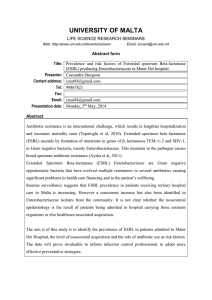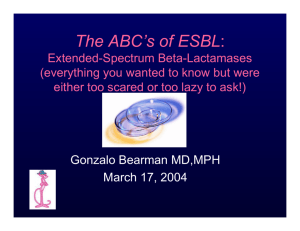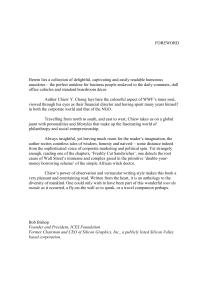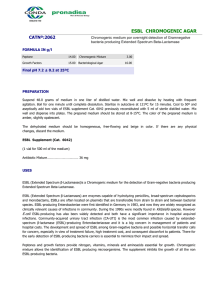ESBL Teleclass Slides - Aug.22.07
advertisement
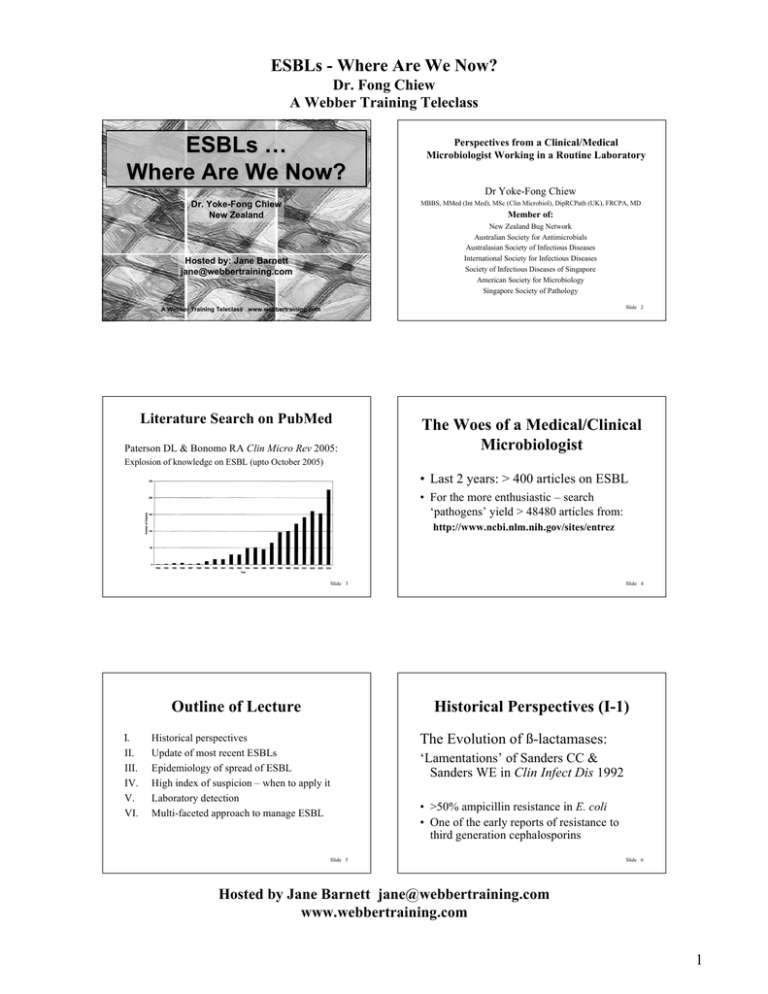
ESBLs - Where Are We Now?
Dr. Fong Chiew
A Webber Training Teleclass
ESBLs …
Where Are We Now?
Perspectives from a Clinical/Medical
Microbiologist Working in a Routine Laboratory
Dr Yoke-Fong Chiew
Dr. Yoke-Fong Chiew
New Zealand
MBBS, MMed (Int Med), MSc (Clin Microbiol), DipRCPath (UK), FRCPA, MD
Member of:
New Zealand Bug Network
Australian Society for Antimicrobials
Australasian Society of Infectious Diseases
International Society for Infectious Diseases
Society of Infectious Diseases of Singapore
American Society for Microbiology
Singapore Society of Pathology
Hosted by: Jane Barnett
jane@webbertraining.com
A Webber Training Teleclass www.webbertraining.com
Slide 1
Literature Search on PubMed
Paterson DL & Bonomo RA Clin Micro Rev 2005:
Slide 2
The Woes of a Medical/Clinical
Microbiologist
Explosion of knowledge on ESBL (upto October 2005)
• Last 2 years: > 400 articles on ESBL
• For the more enthusiastic – search
‘pathogens’ yield > 48480 articles from:
http://www.ncbi.nlm.nih.gov/sites/entrez
Slide 3
Outline of Lecture
!.
II.
III.
IV.
V.
VI.
Slide 4
Historical Perspectives (I-1)
The Evolution of ß-lactamases:
Historical perspectives
Update of most recent ESBLs
Epidemiology of spread of ESBL
High index of suspicion – when to apply it
Laboratory detection
Multi-faceted approach to manage ESBL
‘Lamentations’ of Sanders CC &
Sanders WE in Clin Infect Dis 1992
• >50% ampicillin resistance in E. coli
• One of the early reports of resistance to
third generation cephalosporins
Slide 5
Slide 6
Hosted by Jane Barnett jane@webbertraining.com
www.webbertraining.com
1
ESBLs - Where Are We Now?
Dr. Fong Chiew
A Webber Training Teleclass
Comparison of Ambler and Bush classifications (I-3)
Classification of ß-Lactamases (I-2)
http://upetd.up.ac.za/thesis/available/etd-11042005-080132/unrestricted/01chapter1.pdf
Ambler – Structure Group
Ambler RP. The structure of ß-lactamases. Philos Trans R
Soc Lond B Biol Sci 1980;289:321-31
Bush – Functional Group
Antimicrob Agents Chemother 1989 March; 33(3): 264–270
Slide 7
Definition of ESBL (I-4)
Slide 8
What is it in 2007? (I-5)
• ESBL is acronym for Extended-Spectrum ßLactamases
• First reported in 1983 (Knothe H et al,
Infect 1983)
• Characteristics of ESBL:
• Class A by Ambler or Group 2be by Bush classifications
• Typically, enzymes are plasmid-mediated derived from
older ß-lactamases of TEM and SHV
• In early 2000s, CTX-M derived ß-lactamases are included
• Plasmid-mediated AmpC ß-lactamases, PER, Toho,
etc?
• Chromosomal AmpC in K. pneumoniae & E. coli?
• Integron-mediated ß-lactamases with multidrug
resistances?:
Machado E et al; AAC 2007
Poirel L et al; AAC 2006
Slide 9
Renaming ESBL? (I-6)
• Use clinical approach to depict multiplicity of
enzymes in the same isolate?
• Change to Expanded Spectrum ßLactamases or X-Spectrum ß-Lactamases?
• Useful read on controversies about ESBL and
AmpC ß-lactamases – see Thomson KS, EID
2001
Slide 10
Update of Most Recent ESBLs
(II-1)
Reference
http://www.lahey.org/studies/
Slide 11
Slide 12
Hosted by Jane Barnett jane@webbertraining.com
www.webbertraining.com
2
ESBLs - Where Are We Now?
Dr. Fong Chiew
A Webber Training Teleclass
Update of Most Recent ESBLs (II-2)
Epidemiology of ESBL (III-1)
Paterson DL and Bonomo RA Clin Microbiol Rev 2005
• Important not to restrict singular enzyme per pathogen
• Rather, multiple enzymes can be found within the same
pathogen
• Co-resistances to other antimicrobial groups compound the
complexity (e.g. fluoroquinolones, trimethoprim,
gentamicin, carbapenem)
The pathogens conduct their own conjugation and
transformation experiments (without human funding)
•
•
•
•
•
Europe
North America
South and Central America
Africa
Asia
Slide 13
Epidemiology of ESBL (III-2)
Europe
France – early 1990s 25-35% nosocomial K. pneumoniae
- Year 2000, 30.2% Enterobacter aerogenes
SENTRY 1997 and 1998 - 25 European hospitals (ICU and non-ICU)
21% K. pneumoniae
North America
NNIS 1998-2002 - 6.1% K. pneumoniae from 110 ICUs
- 10% of ICU >25%
- Non-ICU 5.7% K. pneumoniae
- Outpatients 1.8% and 0.4%
Between 2003-2004 – emergence of CTX-M
Slide 14
Epidemiology of ESBL (III-3)
South & Central America
1989 - CTX-M linked to Salmonella enterica spread to many parts of the
continent.
Did the method for detection included CTX in
addition to CAZ?
ICUs (Brazil, Colombia, Venezuela) - 30-60% of klebsiellae
Africa
36.1% of K. pneumoniae from a single South African hospital
CTX-M found in Kenya reported in 2001
Australia
SENTRY 1998-1999 Overall 5% in hospitals
Slide 15
Epidemiology of ESBL (III-4)
Asia
• SENTRY 19898-1999
30.7% K. pneumoniae and 24.5% E. coli.
• Teaching hospital in Beijing reported in 2002 27%
(both K. pneumoniae and E. coli) from blood cultures
• Zhejiang Province (China)
34% E. coli and 38.3% K. pneumoniae
• A Japanese hospital in 1998-1999 25% K. pneumoniae
• Reports of CTX-M from 2001:
India, China, Japan, Korea, Taiwan and spreading
Slide 16
Epidemiology of ESBL (III-5)
Subsequent to 2005:
" !#$%&'()#*+%&,-%.(+-/+,0'(1)23
1&2)'.&2+41,5+)#+!"#$%&'+'#2
("#)*+,-%*'.+
• Co-existence of ESBL, AmpCs and
other ß-lactamases in the same isolate
Slide 17
Slide 18
Hosted by Jane Barnett jane@webbertraining.com
www.webbertraining.com
3
ESBLs - Where Are We Now?
Dr. Fong Chiew
A Webber Training Teleclass
High Index of Suspicion in
Healthcare Settings
– when to apply it (IV-1)
•
•
•
•
A) Endogenous – enemies from within
B) Exogenous – enemies from without
C) Level of infection control
D) Level of antimicrobial utilisation
Others, e.g., antimicrobials & food production
Endogenous:
The Gastrointestinal Tract (IV-2)
• Within the 7 feet or so of intestinal tract
in humans, genetic exchange can occur
between pathogens and/or microbes?
• For e.g. AmpCs from Enterobacter spp
(& others) can pass onto E. coli and K.
pneumoniae and vice versa?
[The same events occur in food animals?]
Slide 19
Exacerbation of Genetic Exchange (IV-3)
• Multiple courses of antimicrobials
• Indwelling catheters
• Multiple premorbid conditions
Slide 20
B. Exogenous – Enemies from
Without (ie in the vicinity) (IV-4)
• Long hospital stay
• Residing in long term care facilities
• Patient in the next cubicle or someone
transferred from elsewhere who harbours
ESBL (hospital, centre, country)
Slide 21
C. Level of infection control (IV-5)
Is this a recent implementation?
For a long time, MRSA was the only
pathogen deserving strict hand hygiene &
not GNR
Slide 22
D. Level of Antimicrobial
Utilisation (IV-6)
What are the significance and
relevance of selective pressure?
Slide 23
Slide 24
Hosted by Jane Barnett jane@webbertraining.com
www.webbertraining.com
4
ESBLs - Where Are We Now?
Dr. Fong Chiew
A Webber Training Teleclass
Is There an Association Between
Cephalosporins Usage and Their
Ccorresponding Resistances? (IV-8)
Monnet D ‘How Antimicrobials Drive Resistance’
ASA 2007 see 6..,788999:'(')#$:#&.:';8#&9(8 (IV-9)
• How much cephalosporins are used
and what are these?
• If cefotaxime (and or ceftriaxone) are
used in far greater excess over
ceftazidime, then CTX (and or ‘CEF’)
predominates?
Slide 25
V. Laboratory Detection (V-1)
Historical perspectives
1988
Jarlier effect – CTX with Augmentin (Jarlier V et al
Rev Infect Dis 1988)
1990
NCCLS– ceftazidime zone <15mm Kirby Bauer
Method for screening
1994
Synergy testing with ceftazidime (Sader HS et al
Diagn Microbiol Infect Dis 1994)
Slide 26
Laboratory Detection (V-2)
1996
Etest with ceftazidime and clavulanate was recommended
(Cormican MG et al JCM)
1996
>50% ESBL E. coli and 29% of ESBL K. pneumoniae were
resistant to cefoxitin and 10% of non-ESBL E.coli and K.
pneumoniae also resistant to cefoxitin
(Jacoby GA & Han P JCM )
2001
Cefpodoxime recommended for screening Clin Microbiol Rev
2001
Slide 27
Current Modern Methods
(V-3)
Slide 28
Law of Serendipity (V-4)
• CLSI – Clinical Laboratory and Standards Institute
• ARMRL - Antibiotic Resistance Monitoring and Reference
Laboratory, Health Protection Agency Centre
for Infections, London
• EUCAST- European Society of Clinical Microbiology &
Infectious Diseases
• Commercial methods – Etest, BD Phoenix, Vitek, Neotabs & others
in association with:
Otago Diagnostic Laboratories (ODL)
Method for the detection of
ß-lactamases in Enterobacteriaceae
Slide 29
Slide 30
Hosted by Jane Barnett jane@webbertraining.com
www.webbertraining.com
5
ESBLs - Where Are We Now?
Dr. Fong Chiew
A Webber Training Teleclass
Observations and Questions from Staff of
ODL in Dunedin Hospital, NZ (V-5)
• Routine laboratory struggles with ESBL detection:
clinical isolates do not conform to behaviour of research
isolates
• Jarlier effect appears obsolete for the detection of
ESBL
• Reference laboratories e.g. ESR Wellington (NZ)
uses it (Jarlier effect)
• Double Disk Test for ESBL from Mount Sinai
Hospital, Toronto, Canada looks plausible
TRICKS OR TREATS
Presented at 2004 NZ National ASID Meeting
Refer Pathology Oct 2005;37(5):371-7
expanded
spectrum
!-lactamases
images
Slide 31
Improved Template for Placement
of Antimicrobial Discs (V-6)
FEP
CAZ
1.8cm
AMC
1.1.8cm
m
1.8cm
1.5cm
1.5cm
CTX
Reference Strain E. cloacae ARL04/111
Demonstrates derepressed AmpC and
ESBL (V-7)
AMC: Augmentin 20/10 µg
CAZ: Ceftazidime 30 µg
CTX: Cefotaxime 30 µg
ATM: Aztrenam 30 µg
CPD: Cefpodoxime 10 µg
FOX:Cefoxitin 30 µg
FEP: Cefepime 30 µg
CPD
FEP
CPD
1.8cm
m
FOX
Slide 32
ATM
FOX
AMC
CAZ
CTX
ATM
Slide 33
Reference Strain E. cloacae
ARL04/173 Demonstrates Inducible
AmpC and ESBL (V-8)
Slide 34
Clinical Isolate E. cloacae
Demonstrates Inducible AmpC and
CTX-M (V-9)
FEP
CAZ
FOX
AMC
CTX
FEP
CPD
CAZ
ATM
AMC
FOX
CTX
Slide 35
CPD
ATM
Slide 36
Hosted by Jane Barnett jane@webbertraining.com
www.webbertraining.com
6
ESBLs - Where Are We Now?
Dr. Fong Chiew
A Webber Training Teleclass
Clinical Isolate E. coli Demonstrates
AmpC-like ß-Lactamase (note
resistance to cefoxitin) (V-10)
ATCC K. pneumoniae 700603 Reference
Strain for ESBL: note cefoxitin
resistance (V-11)
FEP
CAZ
AMC
CPD
FOX
CTX
ATM
Slide 37
NB: Older version of ODL Method was used
Slide 38
VI. Multi-faceted Approach to Manage
ESBL / XSBL (VI-1)
Real vs Apparent (V-12)
Is Epidemiology of ESBL
directed by laboratory methods?
A) Ascertain clinical significance of isolate obtained
B) Reduce unnecessary antibiotic utilisation (& reduce
unnecessary adverse effects too)
C) Determine third generation cephalosporins usage
D) Pharmacokinetics and Pharmacodynamics
E) Infection control
F) Funding
G) Closer collaboration between research and clinical
laboratories
H) Investments by manufacturer on education
I) Manage antimicrobials in food production
Slide 39
A. Ascertain Clinical
Significance of Isolate Obtained
(VI-2)
Is it a contaminant, colonizer
or true invasive pathogen?
Slide 40
Overdiagnosis of Infections (VI-3)
Bruce et al; J Hosp Infect 2001 Oct;49(2):99-108. Review
The quality of measurement of surgical wound infection as
the basis for monitoring: a systematic review
Ehrenkranz NJ et al; Infect Control Hosp Epidemiol 1995
Dec;16(12):712-6
An apparent excess of operative site infections: analyses to
evaluate false-positive diagnoses
Taylor G et al; Am J Infect Control 1990 Oct;18(5):295-9
Effect of surgeon's diagnosis on surgical wound infectionrates
Slide 41
Slide 42
Hosted by Jane Barnett jane@webbertraining.com
www.webbertraining.com
7
ESBLs - Where Are We Now?
Dr. Fong Chiew
A Webber Training Teleclass
A comparison of infection rate using different methods of assessment for
surveillance of total hip replacement surgical site infections (VI-4)
Yoke-Fong Chiew & Jean-Claude Theis ANZ J Surg 2007
46th ICAAC, Session 074/Surgical site infection: Prophylaxis, Prevention and Prevalence
Outcomes of Comparison of 4 Approaches to the Diagnosis of SSI
Interpretation of
Laboratory Results (VI-5)
Close clinician-laboratory interaction
to minimise over-diagnosis and
miss-diagnosis of infections
Slide 43
Metaphorically Speaking…..(VI-6)
Prof Ben de Pauw’s presentation at ISAAR 2007
Slide 44
B. Reduce Unnecessary Antibiotic Utilisation
To Decrease Selective Pressure & Reduce
Unnecessary Adverse Effects Too (VI-7)
• Mazzeo F et al, Pharmacol Res 2005
Hospital-based intensive monitoring of antibioticinduced adverse events in a university hospital.
• Sanford Guide to Antimicrobial Therapy:
http://www.sanfordguide.com/
• John Hopkins Antibiotic Guide:
http://hopkins-abxguide.org/
Slide 45
C. Determine Third Cephalosporins
Usage and Frequency of ESBLs (VI-8)
K Urbanek, M Kolar, Y Loveckova, J Strojil,
and L Santava
Slide 46
D. Choice of Antimicrobials for
Treatment (VI-9)
A Carbapenem?
What are the Pharmacokinetics and
Pharmacodynamics?
Influence of third-generation cephalosporin
utilization on the occurrence of ESBL-positive
Klebsiella pneumoniae strains
J Clin Pharm Ther 1 Aug 2007 32(4): p. 403.
http://highwire.stanford.edu/cgi/medline/pmid;17635342
Slide 47
Slide 48
Hosted by Jane Barnett jane@webbertraining.com
www.webbertraining.com
8
ESBLs - Where Are We Now?
Dr. Fong Chiew
A Webber Training Teleclass
Questions/Problems about PK/PD approach
to prevent emergence of resistance (VI-11)
D. Pharmacokinetics and
Pharmacodynamics (VI-10)
• Polymicrobial infection
• Subtherapeutic dosing in the presence of biofilm formation
arising from indwelling catheters
• Choice of parameters? – for e.g.:Cmax/MIC, AUC/MIC, T>MIC
• MIC is not sufficient to evaluate the PK/PD relationships of
antimicrobial agents.
• PK/PD analysis based on MIC alone can be misleading.
• Protein binding and tissue distribution are important
pharmacokinetic parameters that need to be considered
• Variance of PK in population?
• What is the correct PD index target (static, -1 log, -2 log
drop@24h?, 48h? 5d end point?)
Lessons learnt and
Questions arising from
46th ICAAC Workshops
San Francisco, USA
Slide 49
Slide 50
Questions/Problems about PK/PD approach to
prevent emergence of resistance (VI-12)
Nevertheless……(VI-13)
• Variability in the PD target size ie inoculum.
• Variance of PD for different micro-organisms groups?
• What is the prediction in chronic infection (bone; abscess
formation)
• There are variations in methods and definitions of indices as
well as uncertainty about errors.
• What about combination antimicrobial therapies – synergy,
antagonism, additional effects?
• What about drug interactions with non-antimicrobial agents?
• MICs may be lower or higher for different regions?
• Is PK/PD different for neutropenics and non-neutropenics?
PK/PD is vital to prevent:
• Subtherapeutic dosing which leads
to emergence of resistance
• Overdosing which leads to toxicity
Slide 51
Slide 52
ESBL and Infection Control (VI-15)
E. Infection Control (VI-14)
•
Gould IM et al J Hosp Infect 1996;33:249-62
http://www.documents.hps.scot.nhs.uk/ewr/supp/0450ESBLsupplement.pdf
‘Grampian outbreak’
• Conterno LO et al J Hosp Infect 2007
Impact and cost of infection control measures to reduce nosocomial transmission of
extended-spectrum beta-lactamase-producing organisms in a non-outbreak setting
Plays a vital role in centres where
ESBL rates are low but becomes
desperate when rates >50%
• Mammina C et al Am J Infect Contr 2007
Surveillance of multidrug-resistant gram-negative bacilli in a neonatal intensive care
unit: prominent role of cross transmission
• Muratani T et al Int J Antimicrob Agents 2006
Emergence and prevalence of beta-lactamase-producing Klebsiella pneumoniae
resistant to cephems in Japan
• Ben-Ami R et al Clin Infect Dis 2006
Influx of extended-spectrum beta-lactamase-producing enterobacteriaceae into the
hospital.
Slide 53
Slide 54
Hosted by Jane Barnett jane@webbertraining.com
www.webbertraining.com
9
ESBLs - Where Are We Now?
Dr. Fong Chiew
A Webber Training Teleclass
F. Funding – for what? (VI-16)
For e.g. inadequate staffing and
inadequate training?
And for all of the mentioned VI (A-I)
•
•
G. Closer Collaboration Between
Research and Clinical Laboratories
(VI-17)
Clinical isolates are more complex than
the research ones and they evolve
faster too in clinical settings
Slide 55
H. Contributions by Manufacturer
Towards Combating Antimicrobial
Resistance e.g. ESBL (VI-18)
Priority (amongst others) given to education
concerning: • antimicrobial resistance
• how to sustain shelf-lives of antimicrobials
• benefits to individual patient care
• consequential profit gains
Slide 56
I. Antimicrobial Usage in Food
Production (VI-19)
Direct effects of selective pressure are more
urgent/important on human pathogens?
For e.g. Rapid spread of Staphylococcus aureus with reduced susceptibilities
to vancocmycin widely reported in Europe due to prescriptions in
healthecare - despite withdrawal of avoparcin in food production?
Van Griethuysen A et al JCM 2003; 41:2487-91; Reverdy ME et al 2001;
Nonhoff C et al 2005; Mallaval FO et al 2004; Heym B et al 2002;
Bernard L et al 2004; Garnier F et al 2006; Lecaillon E et al 2002
Slide 57
Nevertheless, Indirect Selective Pressure Is
Eminent & Imminent (VI-20)
•
•
•
•
•
•
•
Mayrhofers et al Microb Drug Resist 2006
Bengtsson B & Wierup M al Anim Biotechnol 2006
Chen J et al Appl Environ Microbiol 2007
Slorach SA Rev Sci Tech 2006
Wagenaar JA et al Rev Sci Tech 2006
Fluckey WM et al J Food Prot 2007
Many others
Slide 58
What Approach Should We
Adopt to Address Antimicrobial
Resistance? (VI-21)
• Gentle approach
• Forceful approach
Slide 59
Slide 60
Hosted by Jane Barnett jane@webbertraining.com
www.webbertraining.com
10
ESBLs - Where Are We Now?
Dr. Fong Chiew
A Webber Training Teleclass
Gentle Historical Approach (VI-22)
French Philosopher Blaise Pascal said:
“No one is strong unless he or she bears within their character
antithesis strongly marked”
In the arena where we watch humans pit their wits against the ingenuity of
microbes, some resemblance to this philosophy may be observed. The
brilliance and tenacity of the human mind that I shall summarily call
‘Thesis’ are in constant battle with the counterbacks from microbes.
‘Anti-thesis’ in the form of Human Arrogance or Despair may well tip
the balance in favour of the counterattacks. Our ‘Thesis’ must be held in
tension with other virtues like Humility or Hope accordingly – where
strength is to be found. And by balancing these virtues, we then become
more fully developed and stronger people.
Taken from MD Thesis ‘The Epidemiology and Laboratory Detection of Resistant
Enterococci’ carried out by Dr Yoke-Fong Chiew at the National University of
Singapore
Modern More Forceful Approach
At The ISAAR 2007 (VI-23)
Dr Keryn Christiansen (Royal Perth Hospital,
Australia) on ‘Managing Antibiotic Policies’
Dr Wing Hong Seto (Queen Mary Hospital, HK) on
‘Immediate Concurrent Feedback’
Dr Walter R Wilson on ‘Pathogens vs Humans’, some
e.g.s: Similaries: Both are diversified competitors
Differences: United (Pathogens) vs Divided (Humans)
Slide 61
Slide 62
Process and Team Efforts Outlined By CDC
Campaign on Combating Antimicrobial
Resistances in Healthcare Settings
Nobel Prizes and
Antimicrobials
• Nobel prize awarded to discovery of penicillin
• Nobel prize to be awarded for capping
antimicrobial resistances or miraculously reversing
the trends for some of them?
What are involved?
Processes and team efforts?
Slide 63
Solution VI (A-I) to Enigma of ESBL
A
B
C
!"#$"%"#"&
Slide 64
The Next South Pacific Teleclass - October 10, 2007
Infection Control Among Refugees
Presented by Dr. Mark Birch
Don’t Give Up
Have a Good Day
D
E
F
G
H
I
Contact:
yfchiew@hotmail.com
For more beautiful jigsaw images
by Mr Stephen Linhart, refer http://www.stephen.com/enigma/e
nigma.html
Slide 65
Slide 66
Hosted by Jane Barnett jane@webbertraining.com
www.webbertraining.com
11
